Sadness in Interwar Britain
In Hilary of their final year, undergraduate historians are tasked with researching and writing a 12,000-word thesis. It is an exciting opportunity to engage with primary material and to form conclusions which develop (or challenge) those of an existing historiography. My own dissertation was an exploration of sadness in interwar Britain and aimed to show that histories of emotion should have an important place in shaping our understanding of the past.
In the early-twentieth century, sadness was being reimagined. Change was brought about by the rise of professional psychology, which gave policy-makers new means to shape how citizens felt. At the same time, the nature of modern life occasioned new concerns about the impact of industrial development on emotional well-being. It was feared that the fast pace of modernity would overwhelm the nervous systems of ordinary men and women, and make them more unhappy.
Historians like Nikolas Rose and Mathew Thomson have already analysed how the British government endeavoured to manage the mood of its people throughout the twentieth century. But there has not yet been an attempt to explain why these efforts implicated sadness, or to question how effective these were in actually determining the subjective experiences of individuals.

Newspaper articles and self-help guides from the time help us to understand how interwar citizens were being encouraged to think about and cope with their unhappiness. Some public figures (authors like Catherine Carswell and May Edginton) wrote about sadness as more than a natural and inevitable emotion: they presented it as an opportunity to create an internal defence mechanism and build up mental resilience. A newfound capacity to endure could be derived from hours spent in melancholy, solitude and even boredom.
The Pelman Institute, an organisation founded in the late-nineteenth century, also imagined sadness as holding the potential for an invaluable source of mental strength and fortitude. Pelmanists advocated what became known as ‘practical psychology’ — the idea that through hard work anyone could use the power of their subconscious to overcome inefficient or unwanted emotion. It was an outlook which placed mental efficiency at the heart of what it meant to be an ideal citizen, and an outlook which placed that responsibility firmly on individuals. By implication, unhappiness could be taken as a sign that someone was either too ignorant or too idle to establish control over their emotions.
However, not all public figures chose to align unhappiness with inefficiency. Self-help authors and medical professionals feared that changes brought about by modernisation would create an emotional imbalance in individuals from all walks of life. Far from an ordinary and expected emotion, sadness was recast as an intolerable symptom of nervous disorder and an endemic by-product of industrialisation. Crucially for interwar citizens, this narrative removed from them the responsibility of managing their own emotional experience.
People living in interwar society were therefore given more than one way to think about and face up to their sadness. Though in the past historians have focused on frameworks built to regulate subjective experience, the question remains: did ordinary men and women simply fit their sadness into frameworks such as these, or did they have the agency to do something different?
An investigation into working-class sadness gives insight into how ordinary people reconciled their own subjective experience with the implications of these narratives. Most newspaper articles and self-help guides had been written by and for the middle-class minority. Consequently, unhappiness was presented as universal and unaffected by unemployment and impoverishment — determining factors of working-class sadness. Sir George Newman, chief medical officer at the newly-formed Ministry of Health, argued that anyone, regardless of economic circumstance, could be held personally responsible for their own mental well-being.
For some amongst the working class, adhering to ideals of emotional composure was a way to re-assert their good citizenship. One diarist wrote in 1931 that although sadness was nearly always the result of circumstances beyond the control of any individual, suffering it alone and in silence was both civic duty and moral imperative. This testimony is evidence that public narratives continued to frame personal ways of thinking and feeling, even as they undermined the legitimacy of working-class emotion.
Yet there were limits to this influence. Many working-class men and women, of all ages and occupations, used projects like Memoirs of the Unemployed (1934) and Men Without Work (1938) to argue that their sadness was intimately tied up with their material circumstance. Indeed it became increasingly evident during the high unemployment of the 1930s that financial insecurity could have an adverse effect on emotional well-being. Some wrote openly about increased anxiety, whilst others lamented the misery and worry of living on the dole.
This decision to challenge an idea central to the prevailing narrative translated into the language of personal source material. Middle-class sources tended to rely on colloquial terms to describe their emotion, but working-class sources drew on the medical discourse of self-help guides to emphasise that sadness was not a personal responsibility. By planting unhappiness amongst other physical symptoms (headaches, nervous irritation, bouts of indigestion), working-class individuals showed that sadness was an embodied experience — one that could not be solved by any act of will.
This history of sadness therefore joins a growing chorus of historians led by Joanna Bourke, who argue that despite the prevailing emphasis on public codes and expectations, representations of sadness are not the whole story. The letters, diaries and memoirs of working-class people lay bare the limitations of public narratives and show that ordinary men and women had a part to play in shaping their own emotional destiny.
Kathryn Jones



